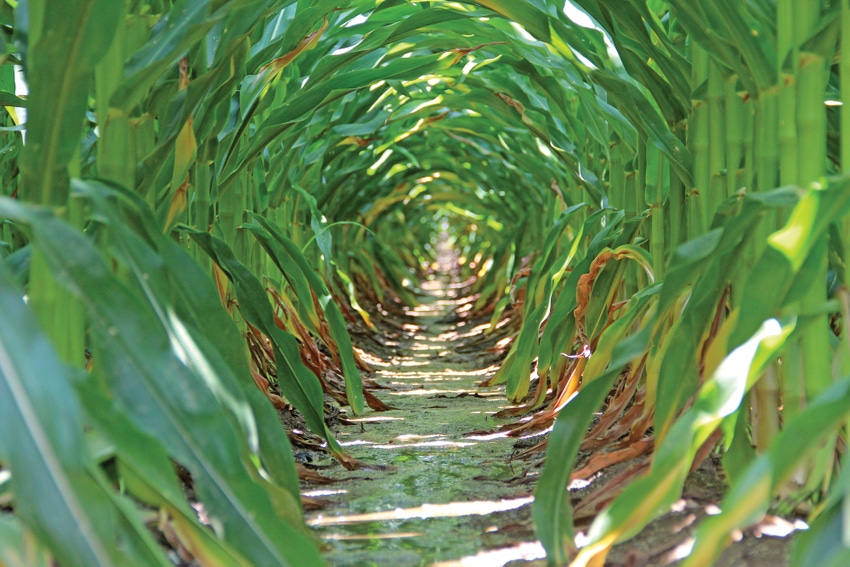August 7, 2013

Late crops and advice for producers to stay focused as crops finish out the 2013 season were common themes of talks at the Corn and Soybean Field Day at the Delta Research and Extension Center in Stoneville, Miss., in mid-July.
On the corn front, Erick Larson, MSU agronomist told the crowd to expect 600,000 to 700,000 actual planted acres in Mississippi, with the earlier 2013 projections just over 1 million.
“Conditions were tough — we had half of March with no growing days. It was almost a real catastrophe until we got about six warmer days. We’ve seen wide variability in the stands,” said Larson. Another unanswered question persists. “Why are we seeing so much kernel tip abortion? With the late emergence, the plant just doesn’t have enough resources,” he said.
With the late crops, some plants hadn’t even reached the milk stage by late July.
Why the market’s ho-hum reaction to this year's late corn crop?…
“It’s been a long, long year for corn with the major issue being all the replanting in 2013,” said Jason Bond, MSU weed specialist. Looking at present weed problems, Bond said herbicide-resistant ryegrass ranks high. “Ryegrass has overwhelmed us. It’s now in 32 counties and if 2012 was a disaster, this year it’s a curse.” Bond recommends producers spray it twice. “We prefer a fall application with a residual. We really like Boundary or Select as an early burndown.”
Speakers urged corn growers to pull their insect traps. “There are a lot of borers, but it’s past where they can do any damage. Pull the traps,” said Don Cook, MSU Extension entomologist.
Angus Catchot, MSU Extension entomologist, agreed. “The numbers are higher, much much higher but pull your traps.”
Jeff Gore, a research entomologist with MSU, said producers will want to avoid having corn make seed at this point. “Shred stalks and leave.”
Tom Eubank, MSU weed scientist and agronomist, added his thoughts. “We’re still chasing planters. Palmer amaranth is a beast.”
MSU agronomists Wayne Ebelhar and Bobby Golden shared insights into current research and crop considerations. “With the support of the corn and soybean boards, we’ve been looking at corn fertility. We’re also studying cultivars using three versus twin-row planting and seeding rates. We’re looking at nitrogen management with pre-tassel applications,” said Ebelhar. In 2013, pre-tassel application research looked at Pioneer 1319 HR, 1739 HR, and 2088 YHR at seeding rates of 30,000 to 40,000. Other current research involves turn rows in corn and soybeans, tillage and burning, and potassium rates.
Golden updated the group on his research, which includes looking at zinc in corn that shows up early in the season at V2-V3. “Zinc is immobile in the soil, but deficiencies are easy to correct.”
MSU Extension pathologist Tom Allen echoed concerns that producers not get sidetracked late in the season. “We’re starting to see northern corn leaf blight, but we’re more concerned about southern rust. The rust is going to look worse as the season advances, but don’t focus on it now. Focus on irrigation,” said Allen.
With the cotton and corn rotation, nematodes have increased. “We’re seeing more and more nematode issues. Corn is a host for root-knot nematode and you can pull roots to look for nodules, but we can’t do anything now in 2013,” said Allen.
Ag news delivered daily to your inbox: Subscribe to Delta Farm Press Daily.
Jason Krutz, MSU Extension service irrigation specialist, reminded everyone that the aquifer depletion in the Delta continues, pushing researchers to refine tools and practices for water conservation. Irrigation scheduling tools have proven to manage water goals.
“If you want to be a better irrigator, put soil moisture sensors in place. We have been working with watermark sensors at 6-, 12- and 24-inch depths. Interesting, our recommendations indicated to set moderately in some cases and freaked people out, but it worked,” said Krutz.
He said the PHAUCET program can save as much as 20 percent in costs while surge valves are another option.
Also:
You May Also Like




